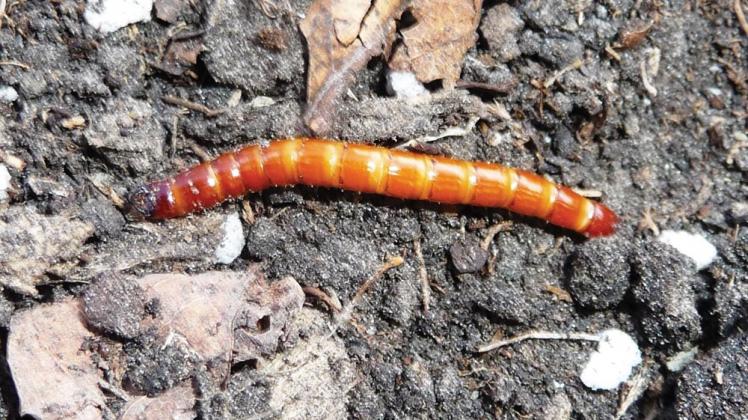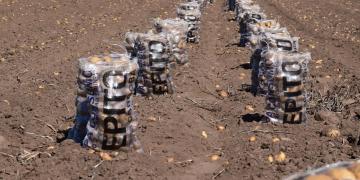Canadá: Manitoba potato growers brace for wireworm issue
The loss of Lindane then Thimet has resulted in growing and booming wireworm populations across Canada.

A budding wireworm problem for Prairie potato growers is the result of losing two key chemical control products.
According to Bob Vernon, a research scientist with Agriculture and Agri-Food Canada in Agassiz, B.C., that lack of control options makes it a question of when, not if, the problem shows up.
First the organophochlorine pesticide Lindane was banned in Canada in 2004, followed by the organophosphate insecticide Thimet last year. Now populations of wireworm have been slowing increasing in some areas — and “booming” in others.
Vernon made his remarks at Manitoba Potato Production Days this past January in Brandon, during an address that looked at wireworm control and using strategic rotational crops to contibute to that effort.
ADVERTISEMENT
Vernon is head of a 15-year national wireworm study, one part of a Canadian Horticultural Council (CHC) project that aims to survey major potato pest species occurring in different agricultural regions across Canada.
Wireworms, the offspring of click beetles, can cause severe damage to potatoes by putting holes in tubers that render them unmarketable.
Along with AAFC technician Wim Van Herk, Vernon is building a wireworm map of Canada, based on wireworm and click beetle samples sent to their lab annually from growers and entomologists across the country. Vernon’s team has identified roughly 20 species that are economically important for potato.
“In Manitoba, we found three or four different species, but one species, Hypnoidus bicolor, a very small wireworm, is by far the most predominant,” he said. “It’s found in probably 75 per cent of the samples we received from Manitoba.”
The second most numerous species of wireworm in the Prairie provinces is Selatosomus destructor. Both species prefer non-irrigated fields.
Even though populations are growing, Manitoba doesn’t have the worst of it — yet.
ADVERTISEMENT
“In some areas of Canada, wireworm populations are going absolutely through the roof… certain areas of B.C., Alberta and P.E.I.,” said Vernon.
His team aims to find replacements for Thimet.
“We’ve been left with the new arsenal of insecticides, such as the neonicotinoids and diamides,” he said. “But what we’re finding is that many of these new insecticides don’t kill. For example, the neonics will intoxicate the wireworms for a long period, so you end up with a good crop, but you don’t kill any wireworms, and they can increase year by year.”
Control
Another aspect of Vernon’s project is management. There are many species of wireworm in Canada, and each species responds differently to the various pesticides registered for their control, so management strategies necessarily vary by region.
“That’s the reason why we’re doing these surveys — to find out which species we have, and try and figure out how we can deal with these different species,” said Vernon. “We’ll deal with them differently in B.C. than in Atlantic Canada.”
ADVERTISEMENT
There are some chemical controls available for wireworm control, including Thimet 20G, but it can only be applied using specific application machinery called a SmartBox, which is still under development.
Bifenthrin — labelled as Capture — is also registered in Canada as of 2014, and can be sprayed into the furrow at planting.
Vernon and colleague Todd Kabaluk are working on developing biological controls using fungi to control wireworms and click beetles. Last year, they developed a new pheromone trap for monitoring the European species of wireworm causing huge problems in P.E.I.
“These work extremely well. We tested them out last year and caught, in three fields, just under a million click beetles, which is a huge number,” he said.
ADVERTISEMENT
The pheromone trap is primarily for monitoring, but can also be used as a mass trapping tool. In 2016, the team plans to conduct formal studies on their use as a control measure. In addition Vernon is studying both chemical and biological methods of killing adults before they lay their eggs.
While Vernon was hesitant to recommend rotational strategies to growers, he did confirm that cereals and grasses are the No. 1 preferred host for click beetles laying eggs.
“So if you rotate potatoes with cereals or grasses, you’ll get egg laying in those fields, and because nothing registered on those crops will kill them, you’ll have a population there the next year,” he said. “In the case of the small species in Manitoba, it takes them two to three years to go from egg back to adult, so you have a problem for the next two to three years. Growers can do with that information what they will.”
If growers choose to plant brassica crops such as canola, they’ll see fewer eggs in potatoes the following year, said Vernon.
The survey will offer much-needed information to growers across the country when it concludes next year, but Vernon says there’s much work still to be done — and not many researchers working on wireworm.
He recommends growers contact their provincial entomologist if they encounter problems with wireworm, and send samples to his lab so the team can refine results by province.
“Knowledge is power. The more you know about wireworms the better you can control them,” he said.
Fuente: http://www.manitobacooperator.ca/crops/manitoba-potato-growers-brace-for-wireworm-explosion/




